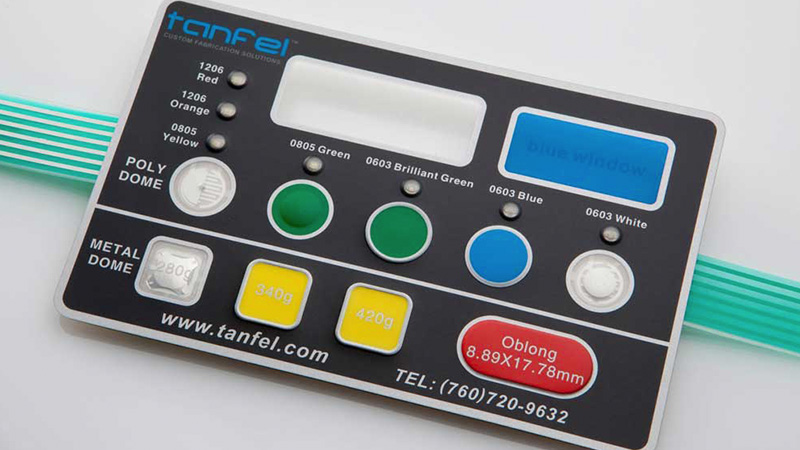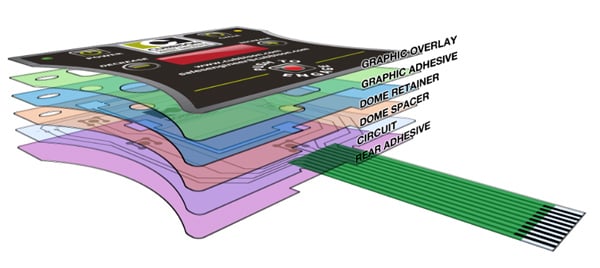Membrane Switch Innovation: The Secret to Reputable and Cost-Effective Interfaces
Membrane switch technology has actually emerged as an essential part in the layout of customer interfaces, supplying both reliability and cost-effectiveness throughout a diverse array of applications. As we check out the complex advantages of membrane layer switches, their possibility for development raises questions about future applications and progressing patterns.
Comprehending Membrane Switch Over Technology
Membrane layer switch technology is a commonly used interface solution in numerous digital gadgets, supplying a seamless mix of performance and layout. This modern technology incorporates multiple layers of materials, usually consisting of a visuals overlay, spacer layer, and a circuit layer. The visuals overlay shows the interface elements, while the spacer layer divides the circuit layer from the overlay till a customer triggers a switch.
When stress is applied to the overlay, the circuit layer finishes the electrical circuit, sending a signal to the tool. This device allows for numerous arrangements, consisting of tactile responses and backlighting options, enhancing customer interaction. Membrane layer buttons are commonly produced making use of sturdy products such as polyester or polycarbonate, guaranteeing long life and resistance to environmental aspects like dampness and dirt.
The flexibility of membrane switches enables their application in varied industries, including clinical gadgets, customer electronics, and commercial controls. Their small layout permits assimilation right into space-constrained atmospheres, offering an efficient user interface without jeopardizing aesthetic charm. Comprehending the intricacies of membrane layer switch modern technology is important for producers and designers seeking to produce trustworthy and effective human-machine interfaces.
Key Benefits of Membrane Buttons
While different interface options exist, membrane layer switches over deal unique advantages that make them a preferred choice in numerous applications. One of the main advantages is their resilience; membrane switches are developed to endure harsh environmental problems, consisting of moisture, dust, and temperature changes, ensuring long-lasting performance. This strength considerably reduces the demand for frequent substitutes, consequently decreasing total upkeep expenses.

In addition, membrane layer buttons are lightweight and compact, making them ideal for applications where space is limited. Their low-profile style contributes to a sleek appearance without compromising capability.
Cost-effectiveness is likewise a remarkable advantage, as the manufacturing procedure for membrane layer switches has a tendency to be cheaper contrasted to traditional mechanical buttons. This cost, incorporated with their reliability and simplicity of installment, placements membrane changes as a sensible option for a variety of sectors looking for efficient and effective interface.
Applications Throughout Numerous Industries
Just how do membrane buttons adjust to the varied needs of various industries? Membrane layer button innovation is increasingly acknowledged for its flexibility, making it suitable for a broad range of applications across numerous fields.
In consumer electronic devices, membrane layer buttons provide a portable service for remote controls and home devices, boosting user experience via user-friendly design. Furthermore, the industrial market leverages membrane switches for machinery control explanation board, profiting from their resistance to harsh settings, such as wetness and dust.
Armed forces and aerospace applications also use membrane layer switches for their reliability and capability to stand up to extreme problems, ensuring operational performance in vital situations. Moreover, the food and drink sector embraces these switches for automated systems, where cleanliness and convenience of operation are paramount. Inevitably, membrane layer buttons are tailored to satisfy the special needs of each industry, proving their essential role in modern-day technology user interfaces
Layout and Personalization Alternatives

In the world of membrane layer switch technology, layout and customization alternatives play a pivotal duty in improving capability and user interaction. These buttons can be tailored to fulfill details operational demands and visual choices, making them flexible components in different applications.
One of the main modification options is the layout of the button itself, which can be created to suit special interface and view it ergonomic factors to consider. By changing the shape, dimension, and plan of buttons, manufacturers can produce user-friendly styles that promote convenience of use. In addition, the consolidation of various colors and graphic overlays permits branding and enhanced exposure, guaranteeing that individuals can rapidly determine features.
Additionally, membrane layer buttons can be crafted with various responsive responses systems, such as elevated switches or distinct clicks, to improve the customer experience. Different materials can additionally be chosen for resilience and environmental resistance, dealing with elements such as wetness, temperature changes, and chemical exposure.
Inevitably, the considerable design and modification alternatives available in membrane button modern technology equip companies to create customized remedies that not only satisfy useful requirements yet likewise align with their branding and operational needs.

Future Patterns in Membrane Layer Switches
As membrane switch innovation continues to develop, future trends are increasingly concentrated on enhancing customer experience and integrating innovative performances. One substantial fad is the combination of touch-sensitive and capacitive technologies into traditional membrane layer switches. This advancement permits more instinctive individual interfaces, offering responsive comments while keeping company website a smooth layout.
An additional arising fad is using ecologically friendly materials, driven by the expanding demand for lasting production methods. Suppliers are looking for to lower their carbon footprint by using recyclable substratums and low-impact inks, aligning with worldwide sustainability objectives.
In addition, the rise of the Internet of Points (IoT) is prompting the incorporation of wise attributes right into membrane switches. Improved connectivity options will certainly enable gadgets to interact with each other, enabling smooth assimilation into wider systems.
Furthermore, advancements in printing innovations, such as electronic printing, are enabling better layout flexibility and customization. This allows suppliers to produce elaborate layouts and dynamic shades cost-effectively.

Final Thought
Finally, membrane layer button modern technology represents a crucial technology in interface layout, using significant benefits in sturdiness, customization, and cost-effectiveness. Its extensive applicability across diverse industries underscores its significance in contemporary technology. As developments remain to emerge, specifically in touch-sensitive user interfaces and lasting materials, the capacity for membrane switches over to improve customer experience and functionality continues to be appealing. Proceeded exploration of this technology will likely yield better renovations and widen its scope in future applications.